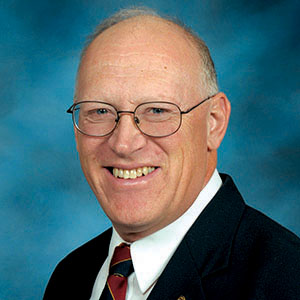Kansas Profile – Now That’s Rural: Mary Billington, Baxter Springs Museum
At a glance: Mary Billington is director of the Baxter Springs Heritage Center and Museum and Visitor’s Center, which shares the story of this historic community and the southeast Kansas region.
More information: Ron Wilson, rwilson@ksu.edu, 785-532-7690
Photos: Ron Wilson | Mary Billington
Website: Huck Boyd National Institute for Rural Development
March 13, 2024

By Ron Wilson, director of the Huck Boyd National Institute for Rural Development at Kansas State University
What town is in the very corner of Kansas?
![]() In southeast Kansas, it is the historic community of Baxter Springs. Today we’ll learn about how this community is honoring its history and that of the region.
In southeast Kansas, it is the historic community of Baxter Springs. Today we’ll learn about how this community is honoring its history and that of the region.
Mary Billington is director of the Baxter Springs Heritage Center and Museum, and the Route 66 Visitor’s Center in Baxter Springs. Baxter Springs is located in Cherokee County.
At right: Mary Billington | Download this photo
Billington grew up in Oklahoma and had family in Missouri. Her career involved bookkeeping and customer service. She also enjoyed history -- especially family history -- and is the family genealogist.
Baxter Springs is positioned between Oklahoma and Missouri, so it was a nice location for Billington. When the museum director position came open, which involved managing finances, sharing history, and providing customer service, a friend told her: “You would be a perfect fit for this.”
Billington became the director of the Baxter Springs Heritage Center and Museum and Visitor’s Center in 2016. Customer service remains a top priority for her. “I want to help people have fun while they’re here, and encourage them to spend extra time in our community,” Billington said.
“Through the decades we’ve had a very active historical society,” Billington said.
During the past half-century, the historical society bought land, built a museum, and expanded it through the years. In addition to raising private funds, the museum receives a mill levy and works closely with city government. “It’s fantastic the way the programs work together,” Billington said.
Baxter Springs received its name from John Baxter who admired the bountiful springs near his homestead. This water, and its location at the midpoint between Fort Leavenworth and Fort Gibson in Indian Territory, made it an ideal camping point along the military road between the forts.
The abundant prairie grass and water surrounding the springs attracted the drovers who were moving longhorn cattle north from Texas along the Shawnee Trail. Before Abilene became famous, Baxter Springs became the first cowtown in Kansas.
Southeast Kansas was also a site of extensive mining of lead, zinc and coal. In the early years, mining operations brought a large influx of workers from diverse ethnic groups but also brought about major environmental consequences. Lead contamination led to the abandonment of the Cherokee County town of Treece, now considered a ghost town. In 2010, Treece was a rural community of 138 people. Now, that’s rural.
Today the Baxter Springs Heritage Center and Museum shares the history of the region. The museum has 20,000 square feet under roof. It attracts visitors who literally come from all over the world.
“Our top five (sources of international visitors) are the United Kingdom, Germany, France, Norway and New Zealand/Australia,” Billington said.
Three blocks from the museum and located on the main highway is the Route 66 Visitor’s Center. That building was originally constructed as a gas station in 1930. In 2005 it was purchased by the historical society. It was remodeled to become the visitor’s center and restored to its 1940s appearance in 2007.
“We’ve had many generous donors through the years,” Billington said.
The visitors center takes its name from the fabled Route 66 highway that carried dispossessed workers west to California during the Dust Bowl era.
“During the Depression we saw people moving to California. Now we’re seeing a reversal,” Billington said. “We’re seeing an influx of people moving back to the Midwest.”
Billington enjoys the people she meets. “You have the opportunity to help people enjoy their day,” she said.
For more information, go to www.baxterspringsmuseum.org.
What town is in the very corner of Kansas? Baxter Springs is located in the very southeast corner of the state, and is promoting and building on its interesting history.
We commend Mary Billington and all those involved with the Baxter Springs Heritage Center and Museum for making a difference with history-based tourism. When it comes to good hospitality in southeast Kansas, they just might have a corner on the market.
And there’s more. There has been a resurgence of interest in Route 66. We’ll learn the reasons why next week.
Audio and text files of Kansas Profiles are available at http://www.kansasprofile.com. For more information about the Huck Boyd Institute, interested persons can visit http://www.huckboydinstitute.org.
***

K‑State Research and Extension is a short name for the Kansas State University Agricultural Experiment Station and Cooperative Extension Service, a program designed to generate and distribute useful knowledge for the well‑being of Kansans. Supported by county, state, federal and private funds, the program has county extension offices, experiment fields, area extension offices and regional research centers statewide. Its headquarters is on the K‑State campus in Manhattan. For more information, visit www.ksre.ksu.edu. K-State Research and Extension is an equal opportunity provider and employer.